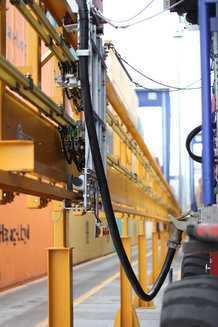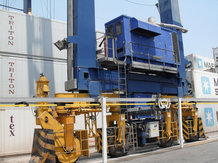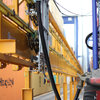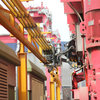New “Drive-In” technologies reduce costs and CO2
RTG Electrification
For years, rubber tyred gantry cranes (RTGs) have driven up costs considerably for port operators. It is not uncommon for these indispensable, diesel-driven cranes to take up half of the total fuel consumption at a port. To noticeably reduce fuel costs, more and more port operators are converting their cranes from diesel to electric – with the trend moving in this direction. The environmentally-friendly approach has already saved several million Euros and tons of CO2 around the globe. And the technologies being used here are constantly being refined. The new “Drive-In L” solution from Conductix-Wampfler is an especially innovative development that already works without any pneumatic or hydraulic components at all.
“The conversion of RTGs from diesel to electric saves up to 95 percent on diesel consumption,” explains Claus Burger, Director of the E-RTG business unit at Conductix-Wampfler. During normal operation, E-RTGs no longer require a diesel motor; this is only necessary when driving from one container corridor to the next or in the waiting area. According to Burger, it is paying off: “If you compare diesel with the expected power costs for operating an RTG, a conversion offers a real chance for achieving savings. These are often so great that the conversion costs – around EUR 150,000 per RTC – are fully amortized in as early as two years.” In addition, forgoing the use of diesel minimizes maintenance and operating costs by up to 70 percent in addition to CO2 emissions and noise pollution around the port. Reason enough to consider alternatives to diesel. But which solution is the best?
Four solutions for each individual range of use
Conductix-Wampfler offers port operators four different systems for the electrification of RTG cranes: The conversion can generally be implemented with motorized cable reels in addition to conductor rails in combination with “plug-in” or “drive-in” systems. In the case of the “Drive-In P” (pantograph) system, the connection between the RTG and conductor rail has an automatic mechanism that makes the manual attachment/detachment required in the case of the “plug-in” solution unnecessary. The brand-new “Drive-In L” (linear) system is completely electrically driven and is used without the need for any pneumatic or hydraulic components.
Electrification with motor-driven cable reels
A motorized cable reel is installed to provide an RTG with power. “Since each RTC is a self-contained system, Conductix-Wampfler offers two basic options,” explains Burger. Both applications are precisely adapted to the unique workflows at the port where they are being used.
On the one hand, Conductix-Wampfler offers modular motorized cable reels with a permanent magnetic coupling, which is a “plug-and-play” system consisting of interchangeable electrical and mechanical components. On the other hand, the port operator can utilize a constantly controlled motorized cable reel system that is equipped with several control units – either in the form of hardware with pre-programmed operations or in the form of software that can be integrated into the existing PLC control systems. Here, built-in video cameras and optical sensors control the movements of the RTG.
“The range of systems offered by Conductix-Wampfler covers both low and high-voltage applications,” according to Burger. A fiber optic core and transmitter can be integrated into the reel or into the cable. “One or more container blocks in the same corridor can be supplied with power from the same motorized cable reel system,” Burger added.
Conductor rail systems with “plug-in” collector trolley
 The conductor rails are attached to a steel structure that stands atop a concrete foundation. Depending on the port operator, this can be anchored to the ground The conductor rails can also be installed at various different heights, offering flexibility once again here,” Burger explained.
The conductor rails are attached to a steel structure that stands atop a concrete foundation. Depending on the port operator, this can be anchored to the ground The conductor rails can also be installed at various different heights, offering flexibility once again here,” Burger explained.
The electrical energy is sourced from the conductor rails through the movement of the
collector trolley back and forth on the steel construction. A power cable and plug-type connector allow the collector trolley to be directly connected with the RTG. “Because the safety aspects play a crucial role at ports, we use conductor contacts that also disconnect the power supply of the plug when the connection is not active,” explains Burger. Two plugs are mounted on the RTG – one on each side in order to ensure the necessary flexibility for the RTG. Conductix-Wampfler installs limit switches on the collector trolley to prevent the crane from leaving the block during electrical operation.
The system upgrade: “Drive-In P” port cranes
When using the “plug-in” solution with the conductor rail, the RTG must be “unplugged” and “plugged in” again when switching between container corridors. The conversion to E-RTG with the “Drive-In” system makes this manual step obsolete since the system upgrade from Conductix-Wampfler makes the manual “plugging in” of the RTG crane into the pantograph carriages of the conductor rail system unnecessary. Instead, when the moving in the RTG crane into the corridor, the pantograph carriage is automatically steered into the guide rails of the steel construction and the pantographs are securely guided into the conductor rails. This “drive-in” solution saves time, energy and thus improves the efficiency of a terminal while having an equal or lesser impact on the environment.
“Drive-in” has already been tested in practice and has taken hold: Since 2009, E-RTGs equipped with the “drive-in” solution have traveled their way about the corridors of the Shekou Container Terminal in China. Founded in 1989, the port was the first international container port in Shenzhen and today is considered as the gateway to the hinterlands of Southern China thanks to its direct access to the Pearl River. Today, Shekou has over nine landing quays with an annual handling capacity of around 8.5 million TEUs. The ninth and most recently built quay was put into service in 2009 to manage the sharply increasing trade volume.
“By electrifying the RTGs we wanted to do our duty in protecting the environment,” stressed David Wan, Deputy General Manager & COO at the Shekou Container Terminal. Another factor is the location of the port, which is regularly subject to high winds. “It's not unusual to see eight typhoons in a single year,” Wan told us. The Chinese were therefore seeking a solution that not only saved on fuel and CO2 emissions, but that would also make it possible to reduce the number of staff needed for dangerous jobs, for example, work on power-conducting cables. In addition to meeting these requirements, the Drive-In system also offers impressively smooth operation and low noise emissions. “We are therefore proud to have played a leading role in the introduction of such a groundbreaking technology,” Wan emphasized.
The new “Drive-In L” solution: maximal flexibility
Conductix-Wampfler has continued to optimize the “Drive-In” solution, which has been used since 2009. The new “Drive-In L” system has an extremely compact design, works completely without pneumatic or hydraulic components and is currently the lightest on the market. This makes it possible to use it for any type of RTG, including those with little space for additional components. The “Drive-In L” was introduced for the first time in September at the TOC Middle East in Dubai. “The response from customers seen there showed us that we have consistently understood their needs and realized an intelligent solution,” emphasized Burger. We therefore expect the product to set completely new standards in the market of RTG electrification.
Thanks to its compact design, the “Drive-In L” – unlike a diesel motor or generator – can be installed on both sides of the RTG, which makes it the most flexible solution of its type currently on the market. The drive-in or drive-out time of the RTG in the case of the “Drive-In L” system is less than 20 seconds. A short drive-in zone also makes it possible to operate the RTG with power from the first row. In addition, this guarantees the compensation for tolerances which result from moving the RTG into the container block or due to lifting and lowering. The procedure with “Drive-In L” is fully automatic and controlled exclusively from the cabin of the RTG. No ground personnel are needed when switching blocks, which also improves work safety at the terminal.
Potential for the future
Conductix-Wampfler has recently realized major contracts for the electrification of RTGs in China, Korea and Japan. New contracts have also been awarded in India and Ecuador. Today, over 1,200 E-RTG systems from Conductix-Wampfler are in use around the world. The demand for “Drive-In” equipment systems has grown noticeably in Europe, too: Before the end of this year, the systems will be employed near Istanbul – in 18 cranes at the Turkish port of Yilport and in cranes at the port of Marport. In addition, Conductix-Wampfler signed a framework contract this year with port operator APM Terminals, which manages 50 port facilities worldwide. The company hopes to gradually convert the majority of its 400 RTGs to electricity. Conductix-Wampfler is currently realizing the first project for APM within this framework agreement at the port of Tanjung Pelepas in Malaysia.
The increasing demand for E-RTG technologies is at the same time accompanied by lower costs for port operators and a reduced impact on the environment. Thanks to E-RTG technologies, today over EUR 71 million have already been saved worldwide; more than 51 million kg CO2 have been prevented from entering the atmosphere.
Burger explained with conviction, “There is a great demand for E-RTG systems and this will continue to grow. We expect that in the future diesel-driven cranes will only be used where there is no power supply for technical reasons.” The new, innovative “Drive-In L” system provides Conductix-Wampfler a trajectory in this lucrative market of the future while at the same time doing an impressive job at underscoring the company's own pioneering role.







